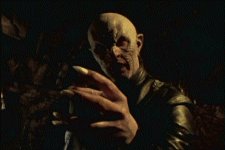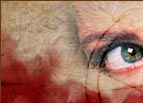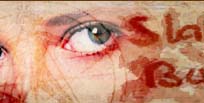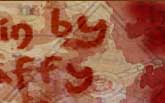|
+VAMPIRES+
Vampires are interesting.
The way they've been represented in films, literature and TV has changed
with society, and continues to change. But there are some things which
remain central to anything, like Buffy the Vampire Slayer, which portrays
vampires. These I call the Rules. The Rules were gradually evolved from
myths some several hundred years ago, and were finally set down in Bram
Stoker's 'Dracula', the main genesis of all vampire stories.
THE
RULES
The first thing any vampire
movie sets down is the Rules, or rather which of them it's going to follow.
The Hammer Horror movies generally followed Bram Stoker's original rules,
but there have been many films and novels which deliberately break them.
Many of the rules are to
do with how vampires must be killed; obviously, this is central to any
vampire-slaying text, but in texts where the vampires aren't necessarily
the clear-cut baddies, this is less central.
-
Vampires
can only be killed by a stake through the heart, sunlight or decapitation.
Some movies attempt to rationalize the vampire myth, and therefore vampires
are often just humans with a need for blood and a dislike for sunlight.
Staking kills them in the same way it kills anyone. But generally, in all
modern vampire stories, vampires are very hard to kill, and feeding on
humans or the blood of other mammals is a necessity. In Buffy, Angel is
a lot like the vampires in movies like 'Near Dark'; essentially human,
but cursed with a need for blood.
 -
Vampires
are unnaturally strong. This is pretty much universal, because vampires
are only threatening if they're dangerous.
-
Vampires
are the embodiment of evil, and have no soul. This is the point of vampires
in the original Bram Stoker novel, and the majority of vampire texts bear
this out; vampires are evil, and are their to be killed. On the other side
are the modern, humanized vampires, which are more like people with a disease,
than human-like monsters. The recent adaptation of Bram Stoker's novel,
and also 'Interview With a Vampire', are somewhere between these two extremes;
vampires are evil, but also tragic, with human qualities. Typically, Buffy
the Vampire Slayer is more complex; vampires are of course soulless, and
similar to zombies, but it's possible for them to regain their soul, ala
Angel. It's also possible for 'neutered' vampires like Spike to exist,
who are demonic and evil, but somehow accepted as 'less evil' than active
vamps. I think Angel is probably unique, being the only vampire who does
good which I can think of. As I've said, in the original myth, the vampires
were essentially evil, and the distinction between good and evil was very
black and white; like most modern texts, BtVS blurs the boundaries between
the two sides.
-
Vampires
can change form, into bats, wolves, etc. One of the more problematic aspects
of vampires, the problem being that cute little bats aren't very scary.
Most modern movies do away with this idea, even though it was central to
the original myth (where vampires are the bestial side of humanity).
-
Vampires
are immortal. Again, in the more scientific vamp stories, vampires are
often perfectly mortal. However in most, immortality is the only advantage
to vampirehood. Of course, with the more angsty, Angel-type vamps, immortality
is almost a burden.
-
Vampires
dislike certain things, but cannot necessarily be killed by them. In the
Bram Stoker novel, vampires dislike garlic and certain herbs (I'm nor sure
if garlic is actually used in the book). They also are adverse to crosses
and holy places in general, although not graveyards, obviously. In Buffy,
vampires obey these rules, but interestingly the fear of the cross was
seen as more mental than physical; as far back as Season 1, vampires were
trying to break free of these boundaries, and master their fear of religion,
and God. This is an example of a modern, psychological slant on the myth.
Typically, in most modern vampire stories garlic and crosses are dismissed
as superstition by the vampires themselves.
-
Vampires
cannot cross running water, except when resting in their coffin. Well,
I think this one died with the dodo, because it seems increasingly impracticable,
what with customs and so on. I'm not sure if you could get a vampire past
the X-ray machine.
-
Vampires
sleep only in a coffin. Well, see above. Though many modern vampires are
known to hang around tombs, your basic 'new vampire' generally sleeps in
a bed. Although with black sheets, of course.
-
Vampires
cannot be seen in mirrors. This is one which is very variable; when vampires
have to pass for human in the real world, frequently this rule is ignored,
and they reflect like anyone else. Buffy sticks to this rule, for the shock
value and the 'Oh, so you really are a vampire' factor.
-
Vampires
can turn a human into a vampire by biting them. This is where parallels
with blood-borne diseases like syphilis and AIDS come in. Bram Stoker's
novel is often seen as an allegory for the sexually-transmitted, and blood-borne,
syphilis. Equally some modern vampire texts have drawn comparisons with
AIDS; thus vampires are not evil, but simply misunderstood, in the same
way that AIDS victims are in no way evil, and are frequently misunderstood.
Therefore the biting becomes a transfer of a disease through the blood.
Buffy the Vampire Slayer deliberately draws itself away from this; it's
made very clear from the very start that vampires are simply evil, and
are no longer human. Vampires become not a symbol of contagion, but a symbol
of, in this case, the evils of growing up, and adolescent angst. Insofar
as the mechanics of vampirizing are concerned, almost all texts maintain
this bite-and-you're-turned aspect.
-
Vampires
have big teeth. Broadly speaking, the more modernized the story, the smaller
the teeth. Buffy goes against this by making vampires hideous and bat-like;
in their vamp face, they're inhuman. This expresses the show's attitude
to vampires; namely, they are something separate from humanity, and are
not human.
Those
are the rules, or at least most of them. I've already touched on what really
interests me about the vampires; namely the way their meaning has changed,
and they've been used as symbols of a variety of different things, many
of which are what are perceived as the ills of society.
WHAT
THEY REPRESENT
Broadly speaking, vampires
have been, and remain, such a pervasive part of society that over the centuries
they have been used to represent almost anything. The reason why vampires
never die out, in the way that other monsters have done, is because they
are continually evolving into different things. Within a framework of this
popular genre, authors and directors have been able to express things they
want to. It's what I call the Simpson's Factor; disguise serious issues
in a familiar framework, and no one complains or tries to censor you. And
equally, there is almost always an audience for vampire stories.
In the original myth, and
the Bram Stoker novel, vampires frequently represent fears of 'foreign
contagion'. This can be in the form of disease brought from foreign lands,
or the fear that foreigners may be more exotic, and more attractive to
women. Dracula's foreigners is central in the novel, as is his seductive
nature. However Dracula also represents the fear that evil can be in apparently
normal people; that evil can not necessarily be easily seen. Dracula plays
upon Victorian fears about sex, and sexuality, particularly in women, as
being a violent andk destructive force for evil.
In the numerous vampire films
made after the book was first published, typically these ideas of the vampire
have been reinforced. Often the vampire has been seen as exciting, rather
than terrifying; however the 'foreigness' of the vampire was always a key
element, and racism and xenophobia are present, to some degree, in most
early vampire or Dracula movies. Interestingly, however, in 'Nosferatu',
the first vampire movie, the figure of the vamp was tragic as well as frightening;
however because he was grotesque, and less sexualized, he was able to be
seen as less threatening.
 More
modern vampires often represent things which are specifically relevant
to one aspect of society. Films like 'The Lost Boys' show vampirism as
a metaphor for juvenile delinquency; rather than being a single, lone figure,
vampires live in packs and terrorize the community. When someone is bitten,
they are subsumed into the pack, or the gang. In the film 'Near Dark',
this gang theme is also present. However the film shows vampires as essentially
human, and without any obvious physical traits. Also, the possibility of
redemption from vampirehood is present; it is possible to become 'normal'
again. More
modern vampires often represent things which are specifically relevant
to one aspect of society. Films like 'The Lost Boys' show vampirism as
a metaphor for juvenile delinquency; rather than being a single, lone figure,
vampires live in packs and terrorize the community. When someone is bitten,
they are subsumed into the pack, or the gang. In the film 'Near Dark',
this gang theme is also present. However the film shows vampires as essentially
human, and without any obvious physical traits. Also, the possibility of
redemption from vampirehood is present; it is possible to become 'normal'
again.
The idea that vampires could
be scientifically possible was explored in some late 70s and early 80s
B-movies, where the vampire myth was deliberately rationalized and Scullyed
into believability; in the movie, vampirism was an infection, and possibly
curable. Though such films were made before the AIDS epidemic began, parallels
with vampirism and contagious diseases are obvious.
Recently there's been a return
to the original style of the early texts. Anne Rice's Vampire novels represent
vampires are tragic figures in part, and I'm certain the rise in awareness
about victims of disease is partly responsible for this. Equally the movie
adaptation of 'Dracula' portrayed the count as not a motiveless monster,
but rather a humanized character drawn to evil by love. The idea of a vampire
being infect because of love, and therefore sex, seems to bear up with
the AIDS parallel. However vampires can been seen, in these texts, are
symbolizing any minority of people who are forced to live underground because
of some compulsion they cannot control.
Similarly 'Blood Ties' (1991)
portrayed 'new vampires', attempting to live in human society without killing.
The immigration of the family of vampires was central to the movie; vampires
were more like a small religious sect trying to escape persecution than
the embodiment of evil on earth. Point of view is key in these types of
modern vampire stories; we see things from the perspective of the vampires,
and our sympathies are with them, rather than seeing them as the big bad
evil, and sympathizing with the hero trying to kill them.
As I've said, in Buffy the
Vampire Slayer, vampires are the big bad evil. In the series, they
chiefly are the symbol of everything a teenager has to go through; therefore
it makes sense that Buffy, as the heroine, spends her time fighting them.
However, the series has borrowed from pretty much all of the other vampire
stories and movies; elements of 'The Lost Boys' are often present
in teenage vampire gangs, as is  Angel
the 'new vampire' I've talked about. BtVS has the advantage that it has
had chance to assemble it's own complex mythology; vampires are demons,
and therefore evil. They only appear human, but are not. Angel
the 'new vampire' I've talked about. BtVS has the advantage that it has
had chance to assemble it's own complex mythology; vampires are demons,
and therefore evil. They only appear human, but are not.
Therefore the grey areas
are not strictly present; Angel is only half-vampire, as it were; he has
a vampire's body, but a human soul, whereas a vampire is really a human's
body with a demon within it, which has no soul. However, Angel's 'dark
side', namely his repressed demonic nature, is a metaphor for the darkness
of humanity, or perhaps the violence in men. This idea of the repressed
returning to wreak havoc is both very Gothic and very Freudian.
Vampires, I think, are unique
in that they are the only monster-myth which has endured so completely.
Frankenstein's monster returns regularly, but it is always a metaphor for
humanity dabbling where it should not. Other monsters do return, but none
is so pervasive world-wide as that of the vampire, and none has changed
it's meaning so radically, while remaining intrinsically the same.
+LINKS+
For more information
on vampires in film, I suggest you go to the 'Pathway
to Darkness'. Ooh, scary...
|




 More
modern vampires often represent things which are specifically relevant
to one aspect of society. Films like 'The Lost Boys' show vampirism as
a metaphor for juvenile delinquency; rather than being a single, lone figure,
vampires live in packs and terrorize the community. When someone is bitten,
they are subsumed into the pack, or the gang. In the film 'Near Dark',
this gang theme is also present. However the film shows vampires as essentially
human, and without any obvious physical traits. Also, the possibility of
redemption from vampirehood is present; it is possible to become 'normal'
again.
More
modern vampires often represent things which are specifically relevant
to one aspect of society. Films like 'The Lost Boys' show vampirism as
a metaphor for juvenile delinquency; rather than being a single, lone figure,
vampires live in packs and terrorize the community. When someone is bitten,
they are subsumed into the pack, or the gang. In the film 'Near Dark',
this gang theme is also present. However the film shows vampires as essentially
human, and without any obvious physical traits. Also, the possibility of
redemption from vampirehood is present; it is possible to become 'normal'
again.
